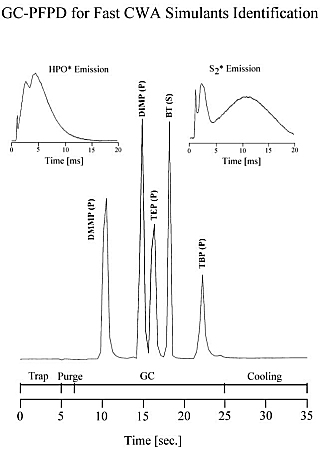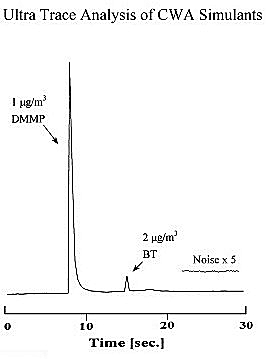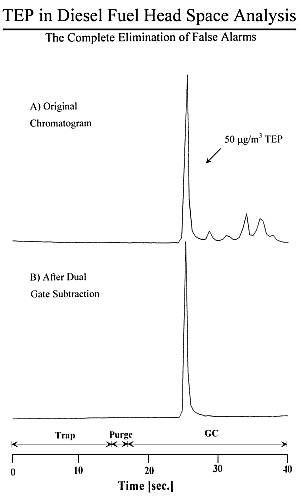Hand Held Fast GC-PFPD System for Field Analysis of Chemical Warfare Agents
Aviv Amirav and Gad Frishman (July 2015)
Can the current chemical warfare agent (CWA) detectors properly analyze CWA in the field?
 Current CWA detectors are confronted with far too many false alarms
(positive & negative) that hampers their usefulness.
Current CWA detectors are confronted with far too many false alarms
(positive & negative) that hampers their usefulness.
 VX cannot be detected at the medically required levels, its detection
response time is too slow and it is masked by its many degradation products.
VX cannot be detected at the medically required levels, its detection
response time is too slow and it is masked by its many degradation products.
 The sensitivity of current detectors is too low, by over 100 times
from the needs of first responders (and early warning).
The sensitivity of current detectors is too low, by over 100 times
from the needs of first responders (and early warning).
 No agent specific identification information is provided as needed
for minimal mask wearing time and for optimal medical, evacuation and decontamination
decision making.
No agent specific identification information is provided as needed
for minimal mask wearing time and for optimal medical, evacuation and decontamination
decision making.
 Agent decontamination cannot be followed or monitored.
Agent decontamination cannot be followed or monitored.
Thus, a new and largely improved field
CWA detector is highly needed
Operational Concept
A hand held fast Gas Chromatograph (GC) system equipped with a Pulsed Flame Photometric Detector (PFPD) was developed. The system was designed for field analysis of the full range of chemical warfare agents (CWA). Both an alarm unit, based on direct atmospheric vapor sampling, and a verifying unit, based on Purge & Trap fast GC analysis are available in the system. Fast GC-PFPD analysis serves as the heart of this system and provides fast response, without false alarms, combined with CWA identification on the molecular level, at the required trace level concentrations.
For GC separation, the analyzed air is pumped through a heated check valve into a miniaturized trap. The collected sample is thermally desorbed and transferred into a short capillary column (1.5 meter, 0.32 mm ID) for its GC separation. Hydrogen serves sequentially for purging, as the GC carrier gas and for PFPD operation.
The detection is performed by the PFPD, simultaneously for all agents, with complete specificity against hydrocarbon interference and with heteroatom identification (P, S, As and possibly also N). The PFPD elemental identification capability is based on elemental specific post pulsed flame emission data processing.
The combination of the PFPD as an element selective detector and GC as a volatility based separation technique, is a very effective way to achieve a clear and unambiguous identification of a chemical compound (not just class) in the field, with practically total elimination of false positive and false negative results.

Why GC-PFPD
A gas chromatograph separates organic compounds according to their volatility and the order of compound elution follows their order of boiling points. The PFPD is an element selective detector which separates the compounds according to their elemental content and detects only P and or S containing compounds while completely eliminating hydrocarbon interference. These separation mechanisms are totally independent and without any correlation (truly orthogonal) and thus this combination is much more effective than any of its components alone in the elimination of false alarms and in the provision of accurate CWA identification at the molecular level.
This is in marked contrast to the combination of GC and IMS whose separation processes provides similar trends.
CWA identification at the molecular level is very important for minimizing mask wearing time due to large difference in the CWA's toxicity, for optimal medical treatment and for the proper decontamination and its monitoring. Without CWA identification, mask wearing as required for protection against VX can be exceedingly long, with its adverse consequence of reduced personnel performance, while mask removal through the assumption of presence of GA of GB can be medically dangerous if VX or GD are present.
The PFPD was originally developed by us and it is the most sensitive and selective FPD and with the lowest hydrogen gas consumption. Further details about the PFPD are available through the Link to the PFPD Web Site.

Advantages and Unique Features


 1. False alarm elimination, using two orthogonal
coupled techniques of separation (GC) and element selective detection (PFPD).
1. False alarm elimination, using two orthogonal
coupled techniques of separation (GC) and element selective detection (PFPD).


 2. Specific CWA molecular identification
for minimal mask wearing time and optimized medical and decontamination procedures.
2. Specific CWA molecular identification
for minimal mask wearing time and optimized medical and decontamination procedures.


 3. Proper VX analysis capability through appropriate sensitivity, heated inlet and GC separation
of VX degradation products.
3. Proper VX analysis capability through appropriate sensitivity, heated inlet and GC separation
of VX degradation products.


 4. Very low detection limits (0.003 microgram/m3
Organophosphorus, 0.2 microgram/m3 Organosulfur) for superior
safety and trace level CWA detection, as required by first responders.
4. Very low detection limits (0.003 microgram/m3
Organophosphorus, 0.2 microgram/m3 Organosulfur) for superior
safety and trace level CWA detection, as required by first responders.

 5. Covers the full range of CWA volatility
(150-300 ºC) with fast response time (heated inlet) and highest sensitivity
for VX type molecules.
5. Covers the full range of CWA volatility
(150-300 ºC) with fast response time (heated inlet) and highest sensitivity
for VX type molecules.

 6. Fast response time. 2 seconds direct
sniff mode, 30 seconds in the GC mode.
6. Fast response time. 2 seconds direct
sniff mode, 30 seconds in the GC mode.
 7. Selective detection capability of As and N
based CWA, in addition to P and S.
7. Selective detection capability of As and N
based CWA, in addition to P and S.
 8. Simultaneous multiple element selective detection
capability (P+S or P+S+As+N) for the coverage of the full range of
CWA.
8. Simultaneous multiple element selective detection
capability (P+S or P+S+As+N) for the coverage of the full range of
CWA.
 9. Short memory time and fast recovery
since only heated Vespel, quartz and capillary GC column surfaces are in
contact with the sampled agents/air.
9. Short memory time and fast recovery
since only heated Vespel, quartz and capillary GC column surfaces are in
contact with the sampled agents/air.
 10. Low gas consumption (4 ml/min). A small
300 gram solid hydride cylinder is sufficient for four days continuous GC
operation or up to a month of continuous alarm operation.
10. Low gas consumption (4 ml/min). A small
300 gram solid hydride cylinder is sufficient for four days continuous GC
operation or up to a month of continuous alarm operation.
 11. Hand Held operation capability through
low energy consumption (16 Watts with GC operation), small size and low
weight.
11. Hand Held operation capability through
low energy consumption (16 Watts with GC operation), small size and low
weight.

 12. No radioactive source,
much larger measurement dynamic range and much smaller humidity effects in
comparison with IMS.
12. No radioactive source,
much larger measurement dynamic range and much smaller humidity effects in
comparison with IMS.

Performance Demonstration
The Fast GC-PFPD system was tested with the five organophosphorus and
organosulfur CWA simulants (below) that cover the volatility range of the
common CWA's and its various performance parameters were investigated and
evaluated. In this section we demonstrate some of the highlights of our research.

Figure 1. Fast (35 seconds) GC-PFPD Analysis.
Fast chromatographic separation and detection of the indicated five CWA simulants is demonstrated. The simulants in their order of elution are dimethylmethylphosphonate (DMMP), diisopropylmethylphosphonate (DIMP), triethylphosphate (TEP), benzothiophene (BT) and tributylphosphate (TBP). The elemental unique PFPD emission time dependencies obtained with this system are shown for phosphorus compounds at the upper left side and for sulfur compounds at the upper right side. The time segments of trap, purge, GC and column cooling are indicated at the lower time bar in seconds. Most of the column cooling time can also serve for sample trapping. Complete analysis cycle time of 35 seconds is demonstrated that was repetitive and automated. Note the baseline GC separation of the 5 simulants that enables agents identification through their elution times and P and/or S elemental content.

Figure 2. Demonstration of Very Low Detection Limits. Ultra trace level analysis of DMMP as a CWA simulant at 1 µgram/m3 concentration level.

Figure 3. False Alarm Elimination Under Complex Matrix Interference Conditions.
Increased selectivity and false alarm elimination is demonstrated through the analysis of low level (50 µgram/m3) of TEP in the head-space of pure commercial Diesel fuel. The upper trace shows the original unprocessed chromatogram while the lower trace shows the chromatogram that was obtained by on-line computer performed dual gate subtraction (DGS). DGS is based on the differences in the pulsed flame emission times of P and S compounds as shown in Figure 1 above.

Our prototype system is ready for laboratory demonstrations with external electronics.
We are looking for an industrial partner for final engineering and commercialization of this detection system.
A detailed manuscript with 15 figures that describes our system was published by us, titled "Fast GC-PFPD System for Field Analysis of Chemical Warfare Agents" G. Frishman and A. Amirav, Field. Anal. Chem. Tech. 4, 170-194 (2000).
For a reprint of this manuscript or for further GC-PFPD system information, please contact me through my E-mail: amirav@tau.ac.il